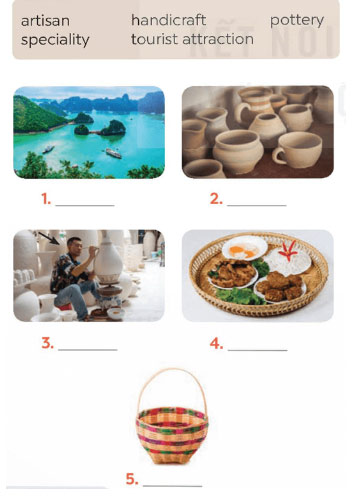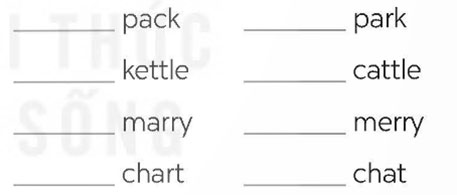Hỗ trợ tư vấn
Tư vấn - Giải đáp - Hỗ trợ đặt tài liệu
Mua gói Pro để tải file trên Download.vn và trải nghiệm website không quảng cáo
Tìm hiểu thêm »Soạn Tiếng Anh 9 Unit 1: A Closer Look 1 giúp các em học sinh lớp 9 trả lời các câu hỏi trang 10 Tiếng Anh 9 sách Kết nối tri thức với cuộc sống bài Unit 1: Local community trước khi đến lớp.
Giải Getting Started Unit 1 lớp 9 bám sát theo chương trình SGK Global Success 9. Thông qua đó, giúp học sinh nhanh chóng nắm vững kiến thức để học tốt tiếng Anh 9 KNTT. Đồng thời, cũng giúp thầy cô tham khảo để soạn giáo án Tiếng Anh 9 theo chương trình mới. Vậy mời thầy cô và các em cùng theo dõi bài viết dưới đây của Download.vn:
Match the community helpers with their responsibilities. (Nối những người phục vụ cộng đồng với trách nhiệm của họ.)
|
1. police officer |
a. puts in, checks, and repairs electrical wires and equipment |
|
2. garbage collector |
b. puts out fires and saves people from dangerous fires |
|
3. electrician |
c. protects people and property, makes people obey the law, prevents and solves crimes |
|
4. firefighter |
d. delivers goods to people's houses or workplaces |
|
5. delivery person |
e. takes people's rubbish away |
Đáp án:
|
1. c |
2. e |
3. a |
4. b |
5. d |
1 – c. police officer: protects people and property, makes people obey the law, prevents and solves crimes
2 – e. garbage collector: takes people's rubbish away
3 – a. electrician: puts in, checks, and repairs electrical wires and equipment
4 – b. firefighter: puts out fires and saves people from dangerous fires.
5 – d. delivery person: delivers goods to people's houses or workplaces.
Hướng dẫn dịch:
1. cảnh sát: bảo vệ người và tài sản, khiến người dân tuân theo pháp luật, ngăn chặn và giải quyết tội phạm
2. nhân viên dọn vệ sinh: lấy rác của người dân đi
3. thợ điện: lắp đặt, kiểm tra và sửa chữa dây điện và thiết bị điện
4. lính cứu hỏa: dập tắt đám cháy và cứu người khỏi những đám cháy nguy hiểm
5. nhân viên giao hàng: giao hàng đến tận nhà hoặc nơi làm việc của người dân
Write a word or phrase in the box under the correct picture. (Viết một từ hoặc cụm từ vào ô bên dưới bức tranh đúng.)

Đáp án:
|
1. tourist attraction |
2. pottery |
3. artisan |
|
4. handicraft |
5. speciality food |
|
Fill in each blank with a word or phrase from the box. (Điền vào mỗi chỗ trống một từ hoặc cụm từ trong khung.)

1. Skilled local _______ made these beautiful flower vases.
2. The electrical wires in our neighbourhood broke down yesterday, so we had to call a(n) _______.
3. Bun cha, pho, and hu tieu are examples of famous Vietnamese _______.
4. The _______ in our street usually comes at 6 p.m. to take the rubbish away.
5. Tourists to Hoi An usually buy traditional _______ such as lanterns as souvenirs.
Đáp án:
|
1. artisans |
2. electrician |
3. speciality food |
|
4. garbage collector |
5. handicrafts |
|
Hướng dẫn dịch:
1. Những nghệ nhân địa phương lành nghề đã làm ra những bình hoa tuyệt đẹp này.
2. Dây điện ở khu phố của chúng tôi bị đứt ngày hôm qua nên chúng tôi phải gọi thợ điện.
3. Bún chả, phở, hủ tiếu là những món ăn đặc sản nổi tiếng của Việt Nam.
4. Người thu gom rác ở phố chúng tôi thường đến lúc 6 giờ chiều. để đem rác đi.
5. Khách du lịch đến Hội An thường mua đồ thủ công truyền thống như đèn lồng về làm quà lưu niệm.
Listen and number the words you hear. Then listen again and repeat. (Hãy nghe và đánh số những từ bạn nghe được. Hãy nghe và nhắc lại.)
Bài nghe:

Đáp án:
- pack /pæk/
- park /pɑːk/
- kettle /ˈket.əl/
- cattle /ˈkæt.əl/
- marry /ˈmær.i/
- merry /ˈmer.i/
- chart /tʃɑːt/
- chat /tʃæt/
Listen and practise the sentences. Underline the bold word with /æ/, circle the bold words with /a:/, and tick the bold words with /e/. (Nghe và thực hành các câu. Gạch chân những từ in đậm bằng /æ/, khoanh tròn những từ in đậm bằng /a:/, và đánh dấu vào những từ in đậm bằng /e/.)
Bài nghe:
1. Thanks to garbage collectors, our streets are clean.
2. My grandmother is a well-known artist.
3. That bakery makes the best bread in our neighbourhood.
4. Do you know where to buy bamboo beds?
5. We sometimes go to the park to relax.
Đáp án:
1.
- thanks /θæŋks/
- garbage /ˈɡɑː.bɪdʒ/
2.
- grandmother /ˈɡræn.mʌð.ər/
- artist /ˈɑː.tɪst/
3. bread /bred/
4.
- bamboo /bæmˈbuː/
- beds /bed/
5.
- park /pɑːk/
- relax /rɪˈlæks/
Hướng dẫn dịch:
1. Nhờ người thu gom rác mà đường phố của chúng ta sạch sẽ.
2. Bà tôi là một nghệ sĩ nổi tiếng.
3. Tiệm bánh đó làm bánh mì ngon nhất khu chúng ta.
4. Bạn có biết mua giường tre ở đâu không?
5. Thỉnh thoảng chúng tôi đến công viên để thư giãn.
Theo Nghị định 147/2024/ND-CP, bạn cần xác thực tài khoản trước khi sử dụng tính năng này. Chúng tôi sẽ gửi mã xác thực qua SMS hoặc Zalo tới số điện thoại mà bạn nhập dưới đây: